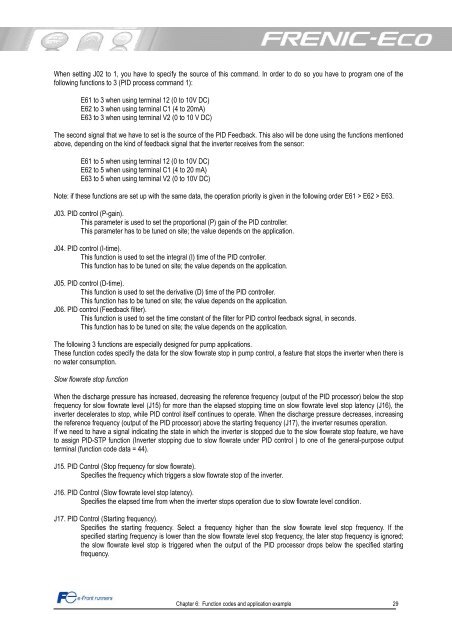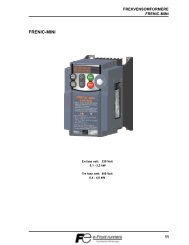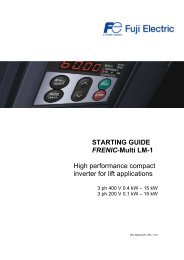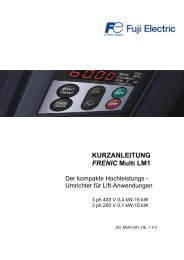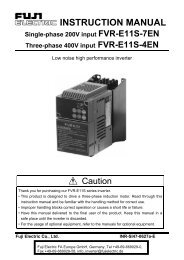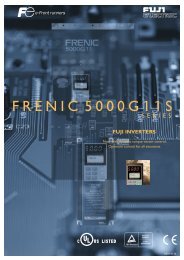STARTING GUIDE FRENIC-Eco . FRN-F1 - Welcome to Fuji Electric
STARTING GUIDE FRENIC-Eco . FRN-F1 - Welcome to Fuji Electric
STARTING GUIDE FRENIC-Eco . FRN-F1 - Welcome to Fuji Electric
You also want an ePaper? Increase the reach of your titles
YUMPU automatically turns print PDFs into web optimized ePapers that Google loves.
When setting J02 <strong>to</strong> 1, you have <strong>to</strong> specify the source of this command. In order <strong>to</strong> do so you have <strong>to</strong> program one of the<br />
following functions <strong>to</strong> 3 (PID process command 1):<br />
E61 <strong>to</strong> 3 when using terminal 12 (0 <strong>to</strong> 10V DC)<br />
E62 <strong>to</strong> 3 when using terminal C1 (4 <strong>to</strong> 20mA)<br />
E63 <strong>to</strong> 3 when using terminal V2 (0 <strong>to</strong> 10 V DC)<br />
The second signal that we have <strong>to</strong> set is the source of the PID Feedback. This also will be done using the functions mentioned<br />
above, depending on the kind of feedback signal that the inverter receives from the sensor:<br />
E61 <strong>to</strong> 5 when using terminal 12 (0 <strong>to</strong> 10V DC)<br />
E62 <strong>to</strong> 5 when using terminal C1 (4 <strong>to</strong> 20 mA)<br />
E63 <strong>to</strong> 5 when using terminal V2 (0 <strong>to</strong> 10V DC)<br />
Note: if these functions are set up with the same data, the operation priority is given in the following order E61 > E62 > E63.<br />
J03. PID control (P-gain).<br />
This parameter is used <strong>to</strong> set the proportional (P) gain of the PID controller.<br />
This parameter has <strong>to</strong> be tuned on site; the value depends on the application.<br />
J04. PID control (I-time).<br />
This function is used <strong>to</strong> set the integral (I) time of the PID controller.<br />
This function has <strong>to</strong> be tuned on site; the value depends on the application.<br />
J05. PID control (D-time).<br />
This function is used <strong>to</strong> set the derivative (D) time of the PID controller.<br />
This function has <strong>to</strong> be tuned on site; the value depends on the application.<br />
J06. PID control (Feedback filter).<br />
This function is used <strong>to</strong> set the time constant of the filter for PID control feedback signal, in seconds.<br />
This function has <strong>to</strong> be tuned on site; the value depends on the application.<br />
The following 3 functions are especially designed for pump applications.<br />
These function codes specify the data for the slow flowrate s<strong>to</strong>p in pump control, a feature that s<strong>to</strong>ps the inverter when there is<br />
no water consumption.<br />
Slow flowrate s<strong>to</strong>p function<br />
When the discharge pressure has increased, decreasing the reference frequency (output of the PID processor) below the s<strong>to</strong>p<br />
frequency for slow flowrate level (J15) for more than the elapsed s<strong>to</strong>pping time on slow flowrate level s<strong>to</strong>p latency (J16), the<br />
inverter decelerates <strong>to</strong> s<strong>to</strong>p, while PID control itself continues <strong>to</strong> operate. When the discharge pressure decreases, increasing<br />
the reference frequency (output of the PID processor) above the starting frequency (J17), the inverter resumes operation.<br />
If we need <strong>to</strong> have a signal indicating the state in which the inverter is s<strong>to</strong>pped due <strong>to</strong> the slow flowrate s<strong>to</strong>p feature, we have<br />
<strong>to</strong> assign PID-STP function (Inverter s<strong>to</strong>pping due <strong>to</strong> slow flowrate under PID control ) <strong>to</strong> one of the general-purpose output<br />
terminal (function code data = 44).<br />
J15. PID Control (S<strong>to</strong>p frequency for slow flowrate).<br />
Specifies the frequency which triggers a slow flowrate s<strong>to</strong>p of the inverter.<br />
J16. PID Control (Slow flowrate level s<strong>to</strong>p latency).<br />
Specifies the elapsed time from when the inverter s<strong>to</strong>ps operation due <strong>to</strong> slow flowrate level condition.<br />
J17. PID Control (Starting frequency).<br />
Specifies the starting frequency. Select a frequency higher than the slow flowrate level s<strong>to</strong>p frequency. If the<br />
specified starting frequency is lower than the slow flowrate level s<strong>to</strong>p frequency, the later s<strong>to</strong>p frequency is ignored;<br />
the slow flowrate level s<strong>to</strong>p is triggered when the output of the PID processor drops below the specified starting<br />
frequency.<br />
Chapter 6: Function codes and application example 29


